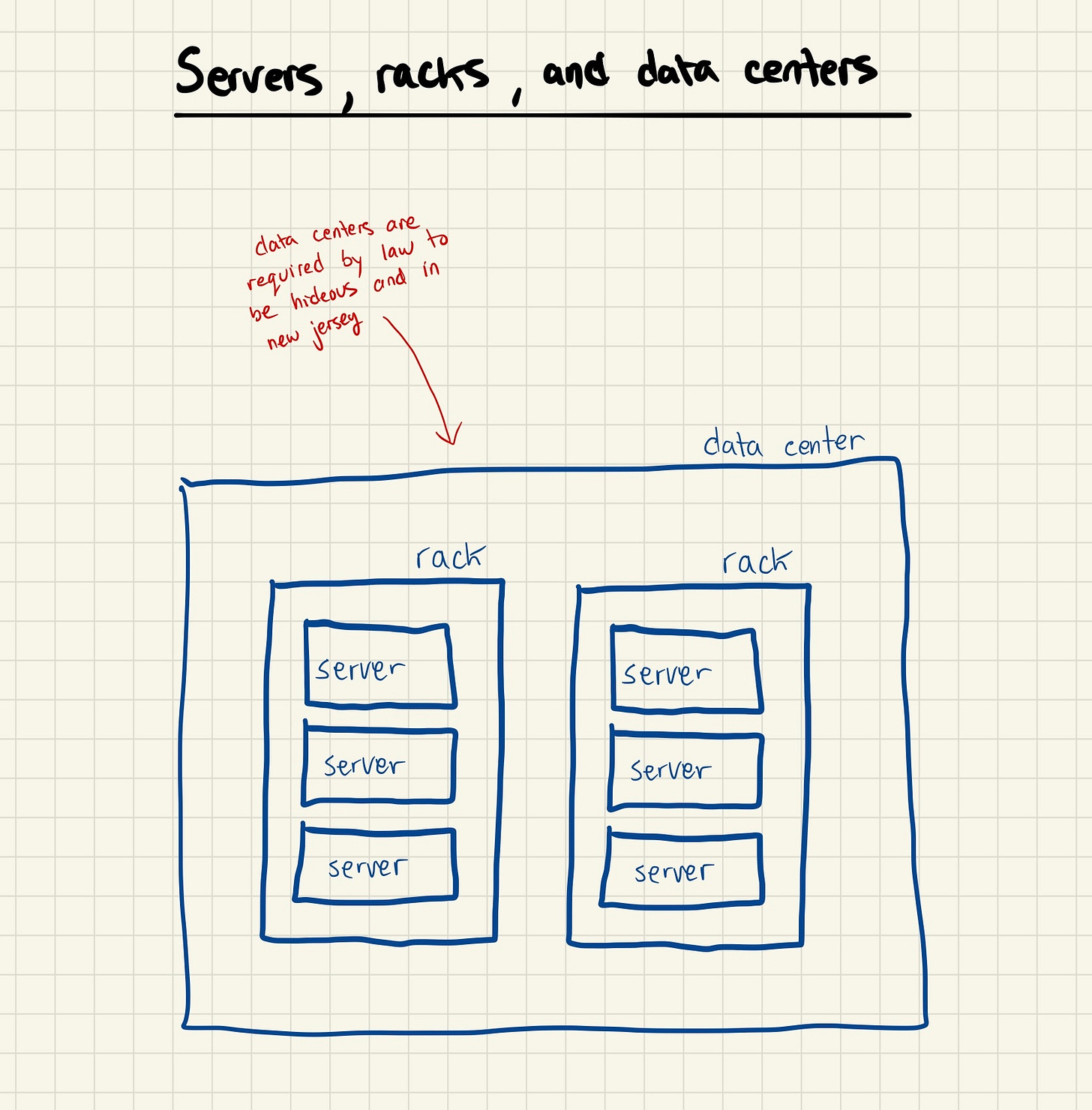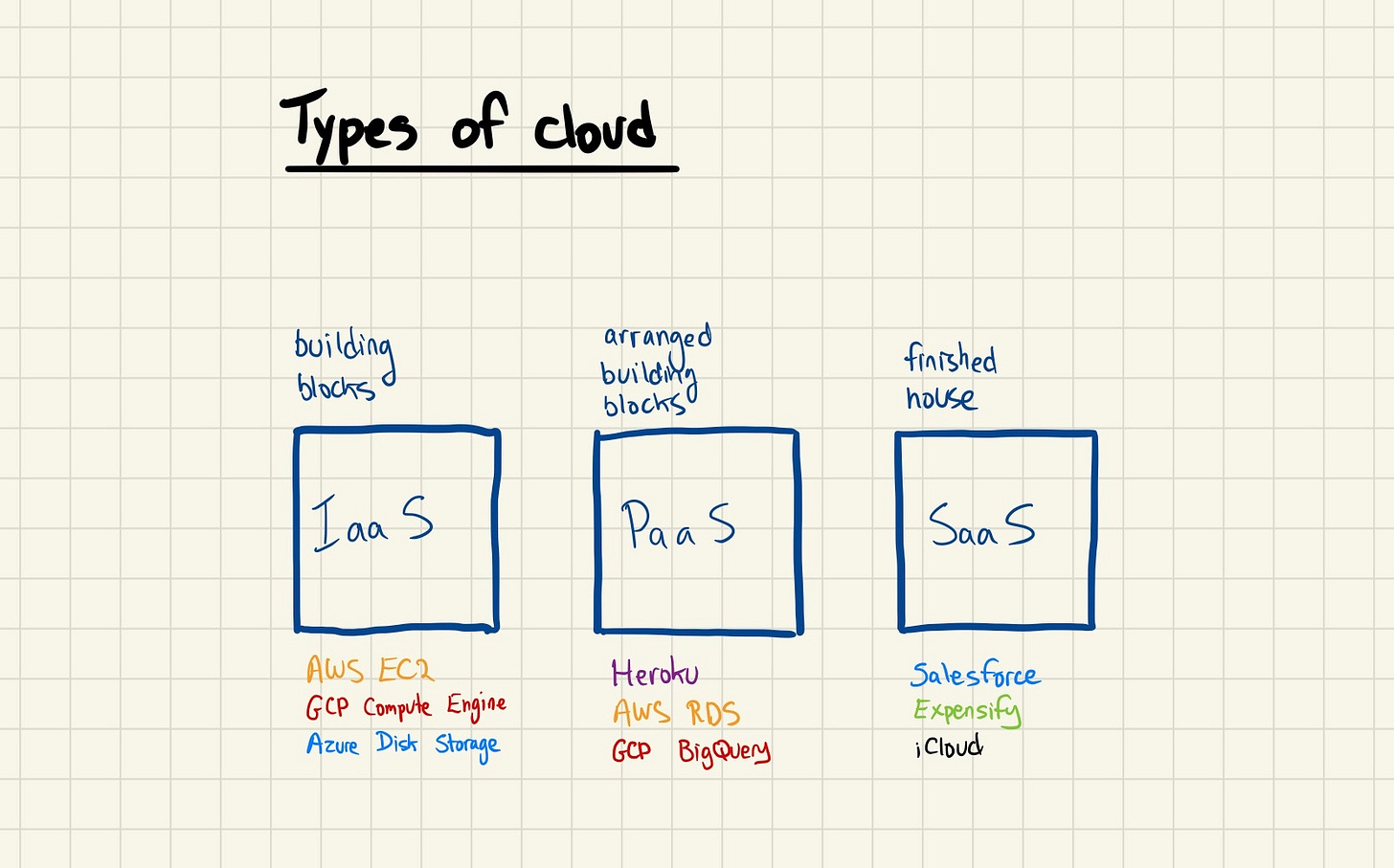What's cloud?
Cloud means renting servers instead of buying them, but also other things too
The TL;DR
Cloud lets companies rent the servers (giant computers) they run their software on instead of buying them.
Companies like AWS buy giant computers called servers and put them together in buildings called data centers
You rent space on those computers in pre-defined pieces of computer power and storage, and access them through the internet
Cloud is transformative because you pay for how much you use, like by the hour, instead of buying expensive equipment up front
Cloud gets delivered in 3 major ways: IaaS, PaaS, and SaaS
Cloud has probably been the single biggest change in computing over the past 20 years, and it’s core to how your company operates. So read this.
What’s cloud?
If you indeed are reading this, chances are you rent an apartment or house instead of owning (the national rental rate in the U.S. is 36%, by the way). Why do you lease instead of buy?
You can’t afford to buy property in the location of your choice (sorry, Texas)
You can change apartments every year
You don’t need to deal with the hassle of maintenance (repairs, renovations, Live Laugh Love™ posters)
These benefits aren’t unique to housing: they pretty much apply to renting anything, like a bike (which is a great way to stay in shape), a gym membership, or a musical instrument. Think about cloud in the same way: you’re renting computers instead of buying them. Let’s look at why that’s important, and not boring.
Running software in the dark ages (i.e. before 2006)
Every company that uses or sells software needs somewhere to run it.
Sometimes that happens on your actual laptop, without the internet, like regular old Microsoft Excel. But other times (most of the time today, in fact) companies will run that software on servers, which is fancy talk for very large, very powerful computers – you’ll then access that software over the internet. Servers aren’t like laptops: they’re optimized for commercial use cases, and look something like this:

A bunch of servers get put together in a rack, and a bunch of racks get put together in a very cold, very ugly building called a data center. That’s software on hardware 101, which will (hopefully) be the subject of another Technically post. But what does this have to do with cloud?
Before the past decade or two, when a company needed to run their software on servers, they’d need to purchase their own servers and racks. Like buying an apartment literally anywhere in New York City, this was astronomically expensive. We’re talking in the millions of dollars to get set up, not to mention the hassle of maintenance and upgrades.
🤔 Undefined Terms 🤔
If you’re wondering what it means to “run software” somewhere, you’re in good company. We’ll tackle that in another post.
🤔 Undefined Terms 🤔

Rent your servers instead of running them!
In 2006, Amazon (you remember them, they sell books) launched Amazon Web Services. The idea was pretty simple: rent your industrial computers, don’t buy them. AWS set up data centers across the U.S. – giant groups of servers – and rented those out over the internet, charging by the hour. It was called EC2, short for Elastic Compute Cloud, and would be the first of many awful, horrible product names.
This was a transformative shift (I learned that phrase in business school) for the exact same reasons that renting apartments is:
Companies could start up and only pay for the computing they used, which eliminated million dollar capital expenditures
Companies can switch cloud providers and products whenever they want, avoiding costly vendor lock-in
Companies saved time and headcount from not having to maintain and upgrade their servers
Today, you’ll hear people refer to non-cloud – i.e. companies running their own data centers – as on prem, short for on premises. The funny thing is that in the long run, cloud isn’t really any cheaper than on prem – the difference is in shifting cost from capital expenditures to operating expenses (CapEx to OpEx, as they say), and eliminating the need for giant up front investments.
🚨 Confusion Alert 🚨
Sometimes, people will use “cloud” – e.g. we run this on our cloud – to refer to the network of data centers that their company has built, even though I just told you that that’s called on prem. This is uncommon, but it can trip you up: that’s why we’ll sometimes use the phrase “public cloud” to make sure we’re talking about generally accessible services like AWS, not your company’s data centers.
🚨 Confusion Alert 🚨

3 types of cloud: IaaS, PaaS, and SaaS
The last piece of the puzzle here is understanding how cloud is delivered and sold. There are 3 basic models, and people can be referring to any of them when you hear them shout “cloud” at their direct reports.
Infrastructure as a Service (IaaS) is when vendors sell you access to very basic computing elements: compute, storage, and networking. You can think of this as an empty piece of land; it’s going to be the cheapest, but it’s not even close to ready to live in. Examples: AWS EC2, AWS EBS, AWS Route 53
Platform as a Service (PaaS) is when vendors add a few features on top of those basic computing elements that make your software deployment process easier. PaaS is more expensive than IaaS, but can save time and money, so it might be worth it. Think of this as an unfurnished apartment: there’s still a bunch of work to do to make it livable, but it’s better than nothing.
Sometimes, the same companies that sell you IaaS will sell you PaaS, and sometimes third party companies will build PaaS on top of another company’s IaaS. A great example is Elastic, which sells their Elasticsearch software deployed on AWS. Other Examples: Heroku, AWS RDS
Software as a Service (SaaS) is when vendors built fully featured, end user focused software (think: made for you to use out of the box) that’s built on cloud. Unless you’ve etched my newsletter into a stone tablet (if you’ve done this: get in touch), you’re reading this on Substack, which is SaaS. Also SaaS: Twitter, Salesforce, Photoshop, Gmail, etc. SaaS is like a fully furnished apartment, ready to go.

“Cloud” in conversation
“The shift to the cloud has been transformative to our business”
We’ve saved a bunch of time by paying AWS all of our money instead of building our own data centers.
“We deploy our software on AWS and use their PaaS for our databases”
Our software runs on AWS’s cloud, and we use some of their value add PaaS services to store our data and save us time.
“Our CSO is afraid of public cloud, so we still run everything in our own data centers”
We build and run our own data centers, because we don’t trust the security of a cloud like AWS. Fun sidebar: AWS is significantly more secure than anything your company is going to build. But that’s none of my business.
“We’re doing a hybrid cloud model to reduce our risk”
We’re using some public cloud and some of our own data centers to hedge our bets and get the benefits of both.
“We never store your data in the cloud so we can keep things private and secure”
We don’t upload any of your data to the cloud over the internet: it stays on your device (like your phone).
Terms and concepts covered
Deploy (software)ServersRacks, Data CentersPublic CloudOn-PremAWSIaaS, PaaS, SaaSFurther reading
Today, AWS is the largest public cloud and Amazon’s most profitable business segment: Google and Microsoft are rushing to catch up
The majority of enterprises implement multi-cloud strategies, where they use more than one IaaS or PaaS provider
Companies with heavy regulatory overhead like insurers and banks have been slow to move to public clouds
If you liked this, subscribe and / or share!



Is Stern undergrad "business school"?